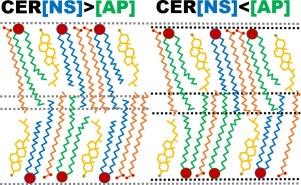Chemistry and Physics of Lipids ( IF 3.4 ) Pub Date : 2018-05-30 , DOI: 10.1016/j.chemphyslip.2018.05.006 Thomas Schmitt , Rakesh Gupta , Stefan Lange , Stefan Sonnenberger , Bodo Dobner , Thomas Hauß , Beena Rai , Reinhard H.H. Neubert

|
For this study mixtures based on the ceramides [NS] (NS = non-hydroxy-sphingosine) and [AP] (AP = α-hydroxy-phytosphingosine) in a 2:1 and 1:2 ratio, together with cholesterol and lignoceric acid, were investigated. These mixtures are modelling the uppermost skin layer, the stratum corneum. Neutron diffraction, utilizing specifically deuterated ceramide molecules, was used to obtain a maximum amount of experimental detail. Highly detailed molecular dynamics simulations were used to generate even more information from the experimental data.
It was possible to observe a single lamellar phase for both systems. They had a lamellar repeat distance of 5.43 ± 0.05 nm for the [NS]/[AP] 2:1 and a slightly shorter one of 5.34 ± 0.05 nm for the 1:2 system. The structure and water content was uninfluenced by excess humidity. Both the experimental and simulation data indicated slightly tilted ceramides, with their C24 chains overlapping in the lamellar mid-plane. This arrangement is well comparable to systems investigated before. The structure of both systems, except for the differing repeat distance, looks similar at first. However, on a smaller scale there were various distinct differences, demonstrating only low redundancy between the different ceramide species, despite only minor chemical differences. The mainly ceramide [AP] determined 1:2 system has a slightly smaller repeat distance. This is a result of a tighter arrangement of the lipids chain along the bilayer normal and increased overlapping of the long chains in the lamellar middle. For the CER[NS] some novel features could be shown, despite it being the overall most investigated ceramide. These include the low adaptability to changed lateral interactions, leading to an increased chain opening. This effect could explain its low miscibility with other lipids.
The investigated model systems allows it to directly compare results from the literature which have used ceramide [NS] to the most recent studies using the phytosphingosine ceramides such as ceramide [AP].
中文翻译:

使用中子散射和分子动力学模拟,神经酰胺亚种对角质层脂质纳米结构的影响。第一部分:CER [NS]的影响
在本研究中,以2:1和1:2的比例基于神经酰胺[NS](NS =非羟基神经鞘氨醇)和[AP](AP =α-羟基植物鞘氨醇)的混合物以及胆固醇和木质酸,进行了调查。这些混合物正在模拟最上层的皮肤层,即角质层。利用特别氘化的神经酰胺分子的中子衍射被用于获得最大量的实验细节。高度详细的分子动力学模拟用于从实验数据中生成更多信息。
可以观察到两个系统的单个层状相。对于[NS] / [AP] 2:1,它们的层状重复距离为5.43±0.05 nm,对于1:2系统,其层距重复距离为5.34±0.05 nm。结构和含水量不受过量湿度的影响。实验和模拟数据均表明神经酰胺略微倾斜,其C24链在层状中平面上重叠。这种安排与以前研究的系统相当可比。两种系统的结构,除了不同的重复距离外,一开始看起来都是相似的。但是,在较小规模上,存在各种明显的差异,尽管化学差异很小,但表明不同神经酰胺之间的冗余度很低。主要由神经酰胺[AP]确定的1:2系统的重复距离略小。这是由于脂质链沿双层法线更紧密的排列以及层状中间的长链重叠增加的结果。对于CER [NS],尽管它是研究最多的神经酰胺,但仍可以显示出一些新颖的特征。这些包括对改变的侧向相互作用的适应性低,导致增加的链开放性。这种作用可以解释其与其他脂质的低混溶性。
所研究的模型系统使其可以直接将使用神经酰胺[NS]的文献结果与使用植物鞘氨醇神经酰胺(例如神经酰胺[AP])的最新研究进行比较。











































 京公网安备 11010802027423号
京公网安备 11010802027423号